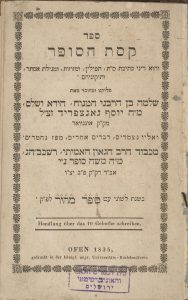Which will be the first one in the Torah (and how does this relate to a Torah scroll)?
Rebecca Ullrich
Anyone skimming through Midrash Bereshit Rabba comes across a very striking passage. In the name of Rabbi Yonah, quoting Rabbi Levi, a question is raised: Why was the world created with the letter „Beit,“ the second letter of the alphabet? Initially, it is stated that one should not explore what was before the creation of the world because the letter ב is closed off on its right side and open on its left; it is closed to the past, but open to the future.
This is followed by an interpretation by Rabbi Yehudah ben Pazzi in the name of Bar Kappara. He answers this question by explaining that the letter ב, with its numerical value 2, indicates that God created two worlds, this world and the world to come. After further interpretations in the name of various rabbis, the interpretation of Rabbi Elazar bar Chanina in the name of Rav Acha follows – and proves particularly interesting:
„For 26 generations, the letter Aleph protested before the throne of God and criticised the Lord of the world: „I am the first of the letters, and you did not create your world with me!“ The Holy One, blessed be He, said to the letter, „The world and its filling were created only because of the merit of Torah, for it says: (Prov 3:19) „Adonai set the earth with wisdom“. Tomorrow I will give the Torah at Sinai and will open the beginning only with you, for it is said: (Exo 20:2) „I (אנכי) am Adonai your God“. „
Genesis Rabba 1,10
God, who presents here a midrash of his own in the style of the rabbis, lets the letter Aleph wait until the next day when he will give Israel the Torah at Sinai, which will begin with an Aleph. According to God, he did not create the world because of a letter, but solely because of the merit of the Torah and to have his teachings obeyed.
This small passage is only one of several instances in rabbinic literature in which letters appear as actors. Genesis Rabbah 47:1, for instance, offers an interpretation in which the letter Yud, the smallest of all Hebrew letters, complains about having been removed from the name of Sarah (Sarah’s name was initially Sarai (Gen 17:15). God calms this letter down too, explaining that he had taken it from the end of a woman’s name and would now put it at the beginning of a man’s name: „And Moses called Hosea bin Nun Yehoshua“ (Num 13:16).
Around the 10th-11th century, more so-called „Smaller Midrashim“ appear that adopt the motif of personifying letters that give life to them. Apart from the beginning of the midrash „Asseret haDibrot“ („Midrash on the Ten Commandments“), the alphabet midrash, attributed to Rabbi Aqiva, is probably the best-known text in which letters appear personified: with voices, emotions and feelings. In this text, which has come down to us in various versions, the letters appear in reverse order before God, from the last to the first letter in the alphabet, one after the other. They ask Him to create the world with them, with interpretations of their forms and decorations.
Rabbinic literature includes several other short texts about more specific phenomena, such as letters to be written in larger or smaller font sizes, as well as letters that receive tagin („crowns“) or a certain dot. These special shapes and decorations are often found in Torah scrolls. Some of them also feature in Masoretic traditions. If so, they are discussed without justification as to why these letters have special features. Later scribal literature, such as Meiri’s Qeriyat Sefer, include lists of letters that need to be written in a larger font size.
The „Smaller Midrashim“ take this a step further and justify these phenomena, discussing, for example, the enlarged spelling of the letter „Beit“ (ב) of בראשית (Gen 1:1) in Torah scrolls. The reason given for the larger spelling of the letter is „that it precedes everything in the Scriptures.“ In the Shema Israel (Dt 6:4-9), too, there are two letters to be written larger in the first verse: The letter ע in שמע („hear“) and the letter ד in אחד („one“). The larger dalet in „Echad“ is needed, so the explanation, to prevent confusion between the letters “Dalet” (ד) and „Resh“ (ר), which look fairly similar, and mistakenly reading „another“ (אחר) instead of “one”. The enlarged letters are reminders for the correct pronunciation of the word at hand. Thus, in these rabbinic texts, letters become carriers of a message: They are assigned attributes in addition to their function of representing a sound. This way, they can also function as memory aids for motifs and events that should be remembered at this point in the text.

